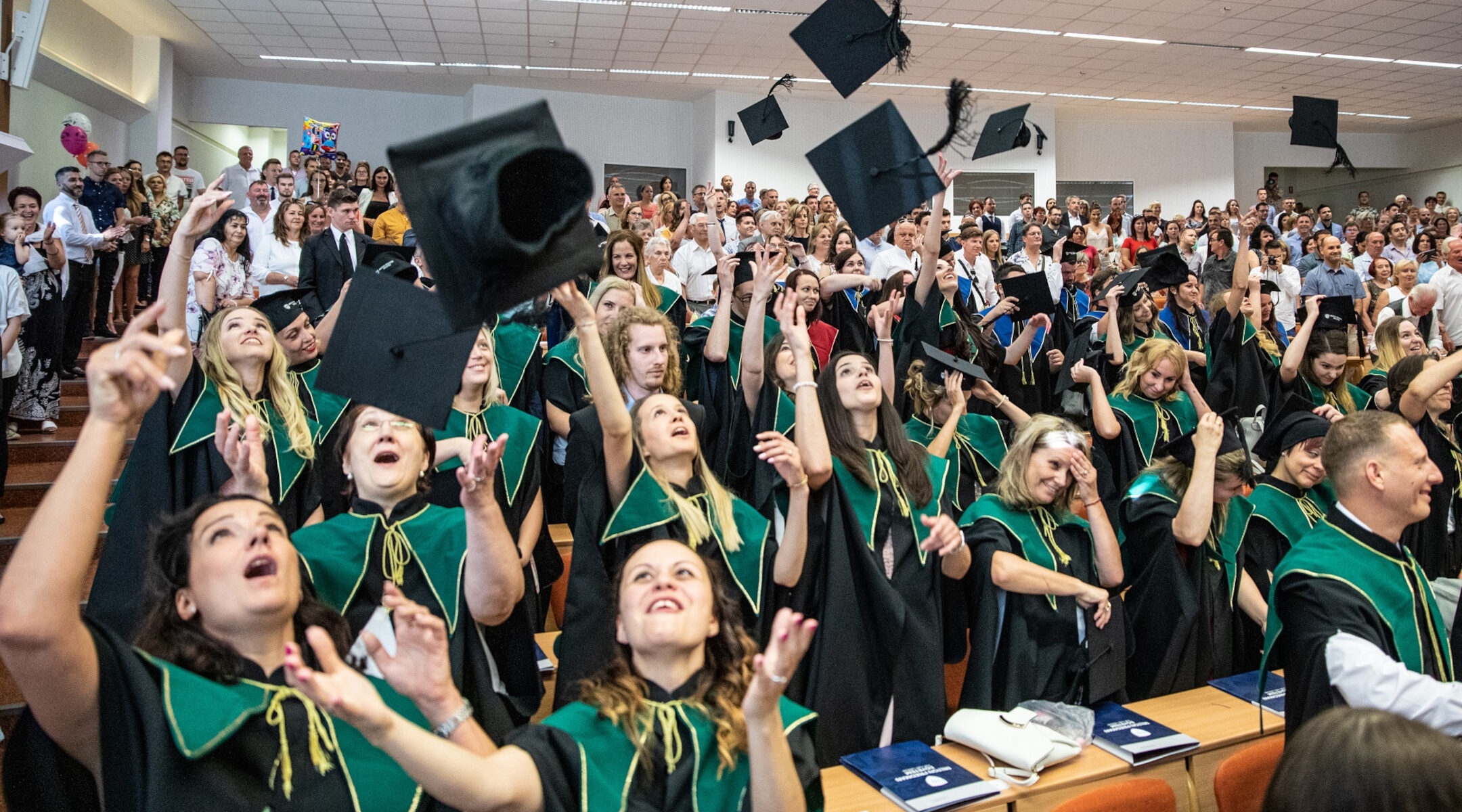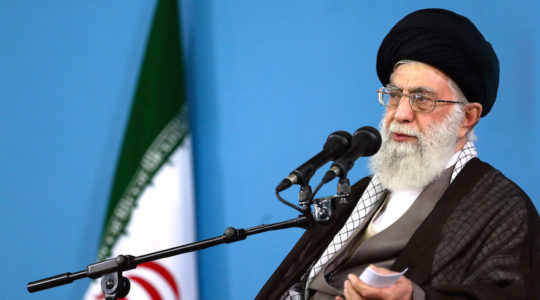BUDAPEST (JTA) — Still a major hub of Jewish thought and culture, Budapest is home to several imposing Jewish institutions, such as the majestic Dohany Synagogue and the 145-year-old University of Jewish Studies.
But arguably the most ambitious institution of them all is tucked away in a drab suburban university campus on Budapest’s northern edge. There, casually dressed young men and women picnic and smoke on lawns surrounding four buildings adjoined by spacious atriums.
This is Milton Friedman University, named after the influential Jewish American economist whose immigrant parents were from what was then part of Hungary (and now is part of Ukraine). It opened in 2018 under the auspices of EMIH, a Hungarian Jewish group affiliated with the Hasidic Chabad-Lubavitch movement.
The school, which goes by MFU, currently has about 700 full-time students, only about 15% of them Jewish. But thanks to a $22 million government grant awarded in May, the school — which has the capacity to grow enrollment nearly sixfold — is looking to expand and turn into a “major player in Hungarian academia,” said Daniel Bodnar, its president.
Running a secular university is unusual for Chabad, an Orthodox movement whose rabbis do community-building work around the world. The group is famous for its efforts to do outreach to less observant Jews, but like other Jews it does not proselytize to non-Jews. But the university is not a religious institution anyway: Most students study business.
EMIH hopes to expand the number of students in the Jewish studies department, called the Ashkenazium, and, according to a recent report, ultimately open a rabbinical school as well.
“In a country where Jewish community life has been decimated in the Holocaust and during communism, the only way for a Jewish community to be relevant is to promote its beliefs and values through the most open and diverse operation possible,” said Rabbi Slomo Koves, the group’s head.

A view of Milton Friedman University in Budapest, Hungary, January 2019. (Courtesy of Milton Friedman University)
EMIH’s detractors say the group is using the university as a strategy to obtain more public funding and clout. “They have no real following in Hungary so they set up shell organizations like MFU, which is not Jewish, and they open up empty synagogues,” charged Zoltan Radnoti, a prominent rabbi from Mazsihisz, the largest Jewish group in Hungary. Mazsihisz is affiliated with Neolog Jewry, a Central European denomination similar to Conservative or Masorti Judaism, and has long had an adversarial relationship with EMIH.
The Chabad-affiliated group, Radnoti charged, “is happy to go along with anything the government says and they get funding in return.”
Koves has rejected these claims, pointing out that Mazsihisz receives far more government funding than EMIH — a fact that Hungarian Deputy Prime Minister Zsolt Semjen confirmed to JTA. The group gets 75% of the government funding for Jewish communities, Semjen said; last year, Mazsihisz inaugurated a new wing in its Jewish Charity Hospital in Budapest, built with a $14 million government grant.
The newly-opened EMIH synagogues — at least five of them have been inaugurated in recent years — are “vibrant and viable,” Koves said. As for the low percentage of Jews at MFU, he said, “just as New York’s Yeshiva University or Mazsihisz’s hospital do not limit their activities to Jews, neither do we.“
The spat, and the university, point to the complicated calculus facing Hungarian Jewish groups right now, as they operate under the leadership of Prime Minister Viktor Orban, a populist who has said he wants to turn Hungary into an “illiberal democracy” and who recently expressed his displeasure of racial mixing.
Mazsihisz has warned that Orban is “encouraging antisemitism” with his ad campaign against George Soros, an American Jewish billionaire who was born in Hungary and funds multiple left-leaning causes, including in Hungary. (Soros moved a university he founded and supported, Central European University, from Budapest to Vienna in 2018 after Orban enacted rules that prevented it from granting degrees.) But Koves has said that there is “nothing antisemitic” in the campaign.
The differences were on display last month, after Orban said that Hungarians “do not want to become peoples of mixed races” and made a joke that appeared to reference Nazi gas chambers in a speech in Romania.
Mazsihisz’s top rabbi, Robert Frolich, called Orban’s remarks “a violation of human dignity and morals.” Koves called them only “unfortunate.”
Koves’ approach reflects the widespread attitude within Chabad that it is appropriate to work with any government that does not put Jews at particular risk. But it reflects the creativity that the 43-year-old rabbi, who has a deep Rolodex as well as a propensity for pulling 16-hour workdays, has employed to turn EMIH from a marginal group into a major force in Hungarian Jewry.

Rabbi Slomo Koves, head of EMIH, stands inside the Star of David-shaped elevated corridor at the House of Fates Holocaust museum, housed in a former railway station that deported Jews to concentration camps, seen in Budapest, Aug. 27, 2021. (Cnaan Liphshiz)
The university was known as King Sisimund College for almost two decades before EMIH bought it in 2018. The classrooms are roomy, but the campus’ age is starting to show. There are two cafeterias, one of which is kosher.
“Most of the budget goes into the students, not the building,” said Adam Gere, a Hungarian-Jewish mathematician who is the college’s CEO.
Situated half an hour’s drive from the center, MFU’s largely residential area boasts some attractions, including a beach on the Danube with multiple bars and restaurants where many MFU students hang out. Most classes are in Hungarian and fewer than 10% of the students are from outside of Hungary.
In the past, many students paid privately for tuition, which can cost a few thousand dollars per academic year, a fraction of what a private university costs in the United States, but still a hefty sum in a country where the average salary is just over $21,000. The new grant is going mostly to reducing the price tag for students, Bodnar said, and this year, for the first time, most students are getting government scholarships.
“Before the funding, MFU was hardly affordable for a significant chunk of the population in Hungary, including many Jews,” Bodnar said about the school, which previously had a $6 million operating budget. “Now it can attract a much broader student population.”
Koves wants that broader population to include more Jews.
“We can do this in two ways: offer Jewish studies, but also simply by making an excellent university with strong economics, communications, business administration and mathematics departments, because that’s where Jewish students traditionally tend to gravitate,” he said.
Mazsihisz also has a university, the Jewish Theological Center, which teaches Jewish studies and social work. It has about 230 students and an annual budget of about $1.5 million, half of which is provided by the government and half by Mazsihisz, according to its vice rector, Gábor Balázs.

An employee of Milton Friedman University in Budapest, Hungary prepares booklets for visitors of the institutions atrium on July 21, 2021. (Courtesy of Milton Friedman University)
But for Jews in academia, Koves added, there is symbolic meaning to a secular university operated by a Jewish group in Hungary, which in 1920 became the first European country to institute a quota limiting Jewish enrollment.
One Jewish student, Oliver Laczko, 19, said he feels “comfortable” at Milton Friedman University because it’s a Jewish school. But he did not enroll there because of that fact and does not feel the need to study anything Jewish there, he said. Like many Hungarian Jews, one of his parents, his father, is not Jewish. His maternal grandfather is also not Jewish and his mother only learned that her mother is Jewish when Laczko’s mother was 20. “I’m interested in my Jewish heritage, but I’m not very observant,” he said.
Another Jewish student, Geri Buzas, who works in security for the Israeli airline El Al, said MFU feels safe because it’s Jewish.
The Milton Friedman University is “a cool place, it’s a laid back place, the lecturers are very high level,” said Buzas, a 24-year-old who is studying for a bachelor’s degree in international affairs, and does not plan to study any Jewish subjects. “But I think it’s also a safe place for me because in the end I’m a Jewish kid.”
JTA has documented Jewish history in real-time for over a century. Keep our journalism strong by joining us in supporting independent, award-winning reporting.






